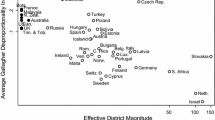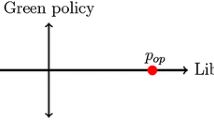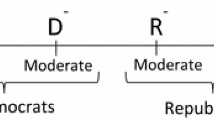Abstract
Models of party competition building on Downs (1957) have recognized that there are centrifugal and centripetal forces in party competition; but one such force, the existence of party primaries, has been remarkably neglected in recent literature. We consider party/candidate policy divergence in two-party competition in one dimension where there is a two-stage electoral process, e.g., a primary election (or caucus) among party supporters to select that party’s candidate followed by a general election. We develop a model in which (some or all) voters in the primary election are concerned with the likelihood that the primary victor will be able to win the general election and being concerned with that candidate’s policy position. This model is similar in all but technical details to that given in an almost totally neglected early paper in Public Choice Coleman (1971) 11:35–60, but we offer important new results on electoral dynamics for candidate locations. In addition to accounting for persistent party divergence by incorporating a more realistic model of the institutions that govern elections in the U.S., the model we offer gives rise to predictions that match a number of important aspects of empirical reality such as frequent victories for incumbents and greater than otherwise expected electoral success for the minority party in situations where that party has its supporters more closely clustered ideologically than the supporters of the larger party (in particular, with a concentration of voters between the party mean and the population mean).
Similar content being viewed by others
References
Adams J (1999) Multicandidate spatial competition with probabilistic voting. Public Choice 99:259–274
Adams J, Merrill S, Grofman B (2006) A unified theory of party competition: party strategies and policy representation in France, Britain, Norway and the United States. Cambridge University Press, New York
Aldrich JH (1983) A Downsian spatial model with party activism. Am Polit Sci Rev 77:974–990
Alesina A, Rosenthal H (1995) Partisan politics, divided government and the economy. Cambridge University Press, New York
Aranson P, Ordeshook PC (1972) Spatial strategy for sequential elections. In: Niemi RG, Weisberg H (eds) Probability models of collective decision making. Charles E. Merrill, Columbus, OH, pp 298–331
Baron DD (1994) Electoral competition with informed and uninformed voters. Am Polit Sci Rev 88(1):33–47
Bernhardt MD, Ingberman DE (1985) Candidate reputations and the incumbency effect. J Public Econ 27:47–67
Black J (1978) The multicandidate calculus of voting: application to Canadian Federal Elections. Am J Polit Sci 22:609–638, August
Brams SJ (1978) Presidential election game. Yale University Press, New Haven, CT
Brams SJ (1980) Spatial models of election competition. University Modules in Applied Mathematics
Brams EJ, Merrill S (1991) Final-offer arbitration with a bonus. Eur J Polit Econ 7:79–82
Brennan G, Lomasky W (1993) Democracy and decision: the pure theory of electoral preference. Cambridge University Press, New York
Budge I, David R, Derek H (eds) (1987) Ideology, strategy and party change: spatial analyses of post-war election programmes in 19 democracies. Cambridge University Press, Cambridge, MA
Bullock C, Brady DW (l983) Party, constituency, and roll-call voting in the U.S. Senate. Legis Stud Q 8:29–43
Cain B (1978) Strategic voting in Great Britain. Am J Polit Sci 22(3):639–655
Coleman JS (1971) Internal processes governing party positions in elections. Public Choice 11:35–60, Fall
Coleman JS (1972) The positions of political parties in elections. In: Niemi RG, Weisberg F (eds) Probability models of collective decision making. Charles E. Merrill, Columbus, OH, pp 332–357
Cooper A, Munger MC (2000) The (un)predictability of presidential primaries with many candidates. Public Choice 103(3-4):337–355
Cox G (1997) Making votes count. Cambridge University Press, New York
Downs A (1957) An economic theory of democracy. Harper, New York
Duverger M (1958) Political parties, their organization and activity in the modern state (B. North and R. North, Trans.) Wiley, New York, Methuen, London
Enelow JM, Hinich MJ (1984) The spatial theory of political competition: an introduction. Cambridge University Press, New York
Enelow JM, Hinich MJ (1990) Advances in the spatial theory of voting. Cambridge University Press, New York
Fedderson TJ (1992) A voting model implying Duverger’s law and positive turnout. Am J Polit Sci 36:938–962
Feld SL, Grofman B (1991) Incumbency advantage, voter loyalty and the benefit of the doubt.J Theor Polit 3(2):115–137
Fiorina M (1974) Representatives, roll calls and constituencies. Lexington Books, Lexington, MA
Glazer A (1993) Political equilibrium under group identification. In: Grofman B (ed) Information, participation and choice: an economic theory of democracy in perspective. University of Michigan, Ann Arbor, MI, pp 81–92
Glazer A, Grofman B, Owen G (1998) A neo-Downsian model of group-oriented voting and racial backlash. Public Choice 97:23–34
Grofman B (1985) Neglected role of the status quo in models of issue voting. J Polit 47:231–237
Grofman B (1993) Toward an institution-rich theory of political competition, with a supply-side component. In: Grofman B (ed) Information, participation and choice: ‘an economic theory of democracy’ in perspective. University of Michigan, Ann Arbor, MI, pp 179–193
Grofman B (1996) Downsian political economy. In: Goodin R, Klingemann, HD (eds) New handbook of political science. Oxford University Press, London
Grofman B (2004) Downs and two-party convergence. Annu Rev Pol Sci 7:25–46
Grofman B, Griffin R, Berry R (1995) House members who become senators: learning from a ‘natural experiment’ in representation. Legis Stud Q 20(4):513–529
Grofman B, Griffin R, Glazer A (1990) Identical geography, different constituencies, see what a difference party makes. In: Johnston RJ, Shelley F, Taylor P (eds) Developments in electoral geography. Croom Helm, London, pp 207–217
Grofman B, Lijphart A (eds) (1986) Electoral laws and their political consequences. Agathon, New York
Lijphart A (1984) Democracies: patterns of majoritarian and consensus government in twenty-one countries. Yale University Press, New Haven CT
Lijphart A (l992) Parliamentary vs. presidential government. Oxford University Press, New York
Lijphart A, Grofman B (eds) (1984) Choosing an electoral system. Praeger, New York
Macdonald SE, Listhaug O, Rabinowitz G (1991) Issues and party support in multiparty systems. Am Polit Sci Rev 85:1107–1131
McKelvey RD (1976) Intransitivities in multidimensional voting models and some implications for agenda control. J Econ Theory 12:472–482
Merrill S (1993) Voting behavior under the directional spatial model of electoral competition. Public Choice 77:739–756
Merrill S, Grofman B (1997) Directional and proximity models of spatial two-party competition: a new synthesis. J Theor Polit 9(1):25–48
Merrill S, Grofman B (1999) A unified theory of voter choice. Cambridge University Press, New York
Merrill S, Grofman B, Brunell T, Koetzle W (1999) The power of ideologically concentrated minorities. J Theor Polit 11(1):57–74
Miller N (1996) Majority rule and minority interests. In: Shapiro I, Hardin R (eds) Political order (Nomos XXXVIII). New York University Press, New York, pp 207–250
Morton R (1993) Incomplete information and ideological explanations of platform divergence. Am Polit Sci Rev 87(2):382–392
Palfrey T, Erikson R (1994) Preemptive spending and entry deterrence by incumbents in congressional elections. Social science working Paper. California Institute of Technology, March
Poole KT, Rosenthal H (1984) The polarization of American politics. J Polit 46:1061–1079
Rabinowitz G, Macdonald SE (l989) A directional theory of issue voting. Am Polit Sci Rev 83:93–121
Riker WH (1982) The two-party system and Duverger’s Law: an essay on the history of political science. Am Polit Sci Rev 6(4):753–768
Robertson D (1987) Britain, Australia, New Zealand and the United States, 1946-1981: an initial comparative analysis. In: Budge I, Robertson D, Hearl D (eds) Ideology, strategy and party change: spatial analysis of post-war elections programmes in nineteen democracies. Cambridge University Press, New York, pp 39–72
Schofield N (l996) The heart of a polity. In: Schofield N (ed) Collective decision-making: social choice and political economy. Kluwer-Nijhoff, Boston, pp 183–220
Shapiro CR, Brady DW, Brody JA, Brody RA, Ferejohn JA (1990) Linking constituency opinion and senate voting scores: a hybrid explanation. Legis Stud Q 15(4):599–623
Shepsle K (1979) Institutional arrangements and equilibrium in multidimensional voting models. Am J Polit Sci 23:27–59
Shepsle KA, Weingast BR (1984) Uncovered sets and sophisticated voting outcomes with implications for agenda institutions. Am J Polit Sci 28(1):49–74
Wittman D (1973) Parties as utility maximizers. Am Polit Sci Rev 18:490–498
Wittman D (1977) Candidates with policy preferences: a dynamic model. J Econ Theory 14:180–189
Wittman D (1983) Candidate motivation: a synthesis of alternative theories. Am Polit Sci Rev 72:78–90
Author information
Authors and Affiliations
Rights and permissions
About this article
Cite this article
Owen, G., Grofman, B. Two-stage electoral competition in two-party contests: persistent divergence of party positions. Soc Choice Welfare 26, 547–569 (2006). https://doi.org/10.1007/s00355-006-0087-1
Received:
Accepted:
Published:
Issue Date:
DOI: https://doi.org/10.1007/s00355-006-0087-1




